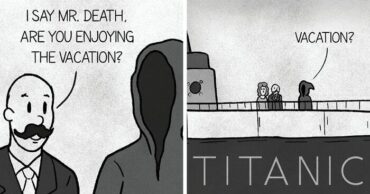The Northern Lights are one of the most magical things a person can ever witness. They are natural phenomena, and seeing them always feels like pure magic. Aurora activity occurs throughout the year, but here in the Nordic regions, we can only see it during the darker months. This means that in Kuusamo, the aurora season usually lasts from late August until early April, at best.
It’s difficult to describe exactly what it feels like to see the Northern Lights. Imagine standing under a deep blue, star-filled sky when suddenly a green light flashes across the heavens, growing brighter and finally beginning to dance in shades of green, red, and blue. Your adrenaline rises, your heartbeat quickens, and a feeling of happiness floods your body. How can anything be this beautiful?
More info: eevamakinen.com | Instagram | Facebook
#1
A corona directly above your head is a fantastic experience. You can see how the aurora begins to grow and form a corona overhead, moving incredibly fast and displaying colors from yellow-green to red and magenta. Blue and purple are also possible, though it’s very hard for the human eye to see, but a camera captures it more easily.

Northern Lights (or aurora borealis) are a natural light phenomenon created when electrically charged particles from the Sun collide with gases in the Earth’s atmosphere. Different colors are formed in different altitudes, and they include green, red, purple and blue.
The appearance of the Northern Lights varies from year to year, and right now we’re experiencing one of the most active aurora periods in decades. In terms of solar activity, there are what are called minimum and maximum phases, and now, we are on the maximum side.
#2

#3

Seeing the Northern Lights often means standing outside in the cold, waiting and watching the sky, meaning it’s not always comfortable. But when the lights finally appear, the joy is so overwhelming that all discomfort disappears. Sometimes you might wait for hours, even if you know how to read aurora data and can estimate when they might appear.
One of the most common questions people ask is: When and where can you see the Northern Lights? With the following images, I’ll show a little more about what kinds of auroras you can see, when you can see them, and how conditions affect visibility.
#4
Among the trees in Riisitunturi National Park lies one of the most iconic winter locations for photographing the Northern Lights. In these images, there’s about a half-moon, providing gentle light on the trees while the auroras remain clearly visible. When heading to Riisitunturi, keep in mind that it’s a bit of a hike, so bring plenty of warm clothing and something hot to drink while you wait.

#5
Along the Norwegian coast, you can see the Northern Lights over the open sea throughout the winter. Snow-capped mountains provide a stunning contrast to the sky and sea. In Northern Norway, it’s quite easy to see large auroras because of the high latitude. During an active year like this, it’s rarer not to see them on a clear night.

The most important factors are darkness and clear skies. If you are lucky to have these conditions and you’re in the north, for example, in Finland, Sweden, or Norway, you have an excellent chance of seeing auroras almost every night, at least this year, thanks to high solar activity.
The Northern Lights are a common topic of conversation among people living in the north. During a solar maximum year like this one, when auroras appear almost nightly if the sky is clear, social media feeds of locals fill up with photos and videos captured on phones and cameras.
#6

#7
Moonlight illuminating snow-covered trees can make the landscape incredibly beautiful, but it also slightly weakens the intensity or visibility of the Northern Lights. The aurora will still appear, but it may look softer or less colorful under a bright moon.

Smartphone cameras have become so advanced that they can now record the Northern Lights not only in photos but sometimes even in videos, especially when the aurora is bright and there’s a bit of moonlight as well.
If you are dreaming of seeing the Northern Lights, these years are the best! But when you do plan your travel to the Nordics – and especially if you are coming from far away – I recommend booking a longer period of staying here. I would recommend a minimum of over a week, but two weeks is always better, both for the climate and also for your chances to get a clear night and experience this magic!
#8
In autumn, before the lakes freeze, it’s possible to see a so-called “double aurora,” where calm water reflects the lights, making them appear twice. I think this is one of the most underrated times to spend in the north. The window is short, but magical. November is often known as a gray and cold month in the Nordics, but it is full of possibilities because of the clear nights, aurora reflections, and crisp days.

#9

#10

#11
When you are thinking of a place to see the Northern Lights, it’s good to select a place where you have a wide-open view to the sky. These places with maximum visibility to the sky can be found in Northern Finland, for example, in Nuorgam. Here, the fells are not so high, giving the most spectacular view in 360 degrees every direction.

#12

#13

 Follow Us
Follow Us





